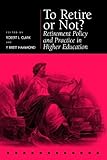To Retire or Not? : Retirement Policy and Practice in Higher Education / ed. by P. Brett Hammond, Robert L. Clark.
Material type: TextSeries: Pension Research Council PublicationsPublisher: Philadelphia : University of Pennsylvania Press, [2017]Copyright date: ©2001Description: 1 online resource (192 p.) : 36 tablesContent type:
TextSeries: Pension Research Council PublicationsPublisher: Philadelphia : University of Pennsylvania Press, [2017]Copyright date: ©2001Description: 1 online resource (192 p.) : 36 tablesContent type: - 9781512821635
- 331.3 23
- LB2334 .T6 2001
- online - DeGruyter
| Item type | Current library | Call number | URL | Status | Notes | Barcode | |
|---|---|---|---|---|---|---|---|
 eBook
eBook
|
Biblioteca "Angelicum" Pont. Univ. S.Tommaso d'Aquino Nuvola online | online - DeGruyter (Browse shelf(Opens below)) | Online access | Not for loan (Accesso limitato) | Accesso per gli utenti autorizzati / Access for authorized users | (dgr)9781512821635 |
Frontmatter -- Contents -- Preface -- 1. Introduction: Changing Retirement Policies and Patterns in Higher Education -- 2. Faculty Retirement at Three North Carolina Universities -- 3. Age-Based Retirement Incentives for Tenured Faculty Members: Satisfying the Legal Requirements -- 4. Survey of Early Retirement Practices in Higher Education -- 5. Cornell Confronts the End of Mandatory Retirement -- 6. The University of California Voluntary Early Retirement Incentive Programs -- 7. Ending Mandatory Retirement in Two State Universities -- 8. Intangible and Tangible Retirement Incentives -- 9. Faculty Retirement: Reflections on Experience in an Uncapped Environment -- 10. Reflections on an Earlier Study of Mandatory Retirement: What Came True and What We Can Still Learn -- Contributors -- Index
restricted access online access with authorization star
http://purl.org/coar/access_right/c_16ec
Colleges and universities across the country face huge challenges as their faculties age, their budgets stagnate, and mandatory retirement becomes a thing of the past. In To Retire or Not? the nation's foremost authorities on retirement policy and practice provide a critical assessment of academic labor markets and retirement patterns, explaining how to adjust pension and other incentive programs to ensure proper replenishment of intellectual and human capital. Case studies vividly illustrate how to predict the need for special retirement programs, how to structure voluntary early-out benefit plans, and how age-based retirement incentives work in practice. Recent legal decisions are assessed and critiqued.A recent amendment to the U.S. Age Discrimination in Employment Act ended mandatory retirement for tenured faculty at colleges and universities across the country. This law let individual faculty members enjoy an economic benefit enjoyed by almost all other American workers: they could choose to continue working past age 70 or "sell" the benefit back to their universities in exchange for earlier retirement. At the same time, however, educational administrators were faced with a faculty bulge created by the expansion of the professorate in the 1960s and early '70s, and the so-called "surplus army" of Ph.D.s of the 1980s. Colleges and universities everywhere are now faced with the higher costs of retaining senior professors instead of hiring entry-level replacements at lower salaries.
Mode of access: Internet via World Wide Web.
In English.
Description based on online resource; title from PDF title page (publisher's Web site, viewed 24. Apr 2022)


